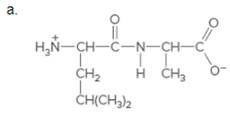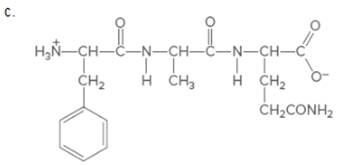
General, Organic, & Biological Chemistry
3rd Edition
ISBN: 9780073511245
Author: Janice Gorzynski Smith Dr.
Publisher: McGraw-Hill Education
expand_more
expand_more
format_list_bulleted
Concept explainers
Textbook Question
Chapter 21.4, Problem 21.6P
Identify the N-terminal and C-terminal amino acid in each peptide.
b. Arg-His-Asn-Tyr
d. Val-Thr-Pro-Phe
Expert Solution & Answer
Want to see the full answer?
Check out a sample textbook solution
Students have asked these similar questions
C. AMINO ACIDS AND PEPTIDES
Consider the structure of the peptide, Asn-Gln-Gly-Ala.
H₂N.
OH
Asn-Gln-Gly-Ala
NH₂
1. How many peptide bonds are present?
2. What is the N-terminal amino acid? Provide the three-letter name.
3. What is the C-terminal amino acid? Provide the three-letter name.
H₂N,
+ H₂N-
Protein
CPMV
N
For each tripeptide: [1] identify the amino acids that form the peptide; [2] label the N- and C-terminal amino acids; [3] name the tripeptide using three-letter symbols.
Chapter 21 Solutions
General, Organic, & Biological Chemistry
Ch. 21.2 - In addition to the amino and carboxyl groups, what...Ch. 21.2 - Draw both enantiomers of each amino acid in...Ch. 21.2 - Prob. 21.3PCh. 21.3 - Draw the structure of the amino acid valine at...Ch. 21.3 - Identify the amino acid shown with all uncharged...Ch. 21.4 - Identify the N-terminal and C-terminal amino acid...Ch. 21.4 - Prob. 21.7PCh. 21.4 - Prob. 21.8PCh. 21.4 - Prob. 21.9PCh. 21.4 - Prob. 21.10P
Ch. 21.4 - Prob. 21.11PCh. 21.5 - Prob. 21.12PCh. 21.6 - Prob. 21.13PCh. 21.6 - Prob. 21.14PCh. 21.6 - Prob. 21.15PCh. 21.7 - Why is hemoglobin more water soluble than ...Ch. 21.8 - Prob. 21.17PCh. 21.8 - Prob. 21.18PCh. 21.9 - Prob. 21.19PCh. 21.9 - Prob. 21.20PCh. 21.9 - Prob. 21.21PCh. 21.9 - Prob. 21.22PCh. 21.10 - Prob. 21.23PCh. 21.10 - Prob. 21.24PCh. 21.10 - Prob. 21.25PCh. 21.10 - Prob. 21.26PCh. 21.10 - Prob. 21.27PCh. 21.10 - Prob. 21.28PCh. 21.10 - Prob. 21.29PCh. 21.11 - Prob. 21.30PCh. 21 - The amino acid alanine is a solid at room...Ch. 21 - Why is phenylalanine water soluble but...Ch. 21 - Draw the structure of a naturally occurring amino...Ch. 21 - Draw the structure of a naturally occurring amino...Ch. 21 - For each amino acid: [1] draw the L enantiomer in...Ch. 21 - For each amino acid: [1] draw the L enantiomer in...Ch. 21 - Draw both enantiomers of each amino acid and label...Ch. 21 - Which of the following Fischer projections...Ch. 21 - For each amino acid: [1] give the name; [2] give...Ch. 21 - For each amino acid: [1] give the name; [2] give...Ch. 21 - (a) Identify the amino acid shown with all...Ch. 21 - Prob. 21.42PCh. 21 - Prob. 21.43PCh. 21 - Draw the structure of the neutral, positively...Ch. 21 - Prob. 21.45PCh. 21 - Prob. 21.46PCh. 21 - (a) Draw the structure of the two possible...Ch. 21 - Prob. 21.48PCh. 21 - Prob. 21.49PCh. 21 - For each tripeptide: [1] draw the structure of the...Ch. 21 - Prob. 21.51PCh. 21 - For each tripeptide: [1] identify the amino acids...Ch. 21 - Prob. 21.53PCh. 21 - Prob. 21.54PCh. 21 - Prob. 21.55PCh. 21 - Prob. 21.56PCh. 21 - Prob. 21.57PCh. 21 - Prob. 21.58PCh. 21 - Prob. 21.59PCh. 21 - Prob. 21.60PCh. 21 - Prob. 21.61PCh. 21 - Prob. 21.62PCh. 21 - What type of intermolecular forces exist between...Ch. 21 - What type of interaction occur at each of the...Ch. 21 - Prob. 21.65PCh. 21 - Draw the structures of the amino acids tyrosine...Ch. 21 - Prob. 21.67PCh. 21 - Prob. 21.68PCh. 21 - Prob. 21.69PCh. 21 - Prob. 21.70PCh. 21 - Prob. 21.71PCh. 21 - Hydrogen bonding stabilizes both the secondary and...Ch. 21 - Prob. 21.73PCh. 21 - Prob. 21.74PCh. 21 - Prob. 21.75PCh. 21 - Prob. 21.76PCh. 21 - What class of enzyme catalyzes each of the...Ch. 21 - What class of enzyme catalyzes each of the...Ch. 21 - Prob. 21.79PCh. 21 - Prob. 21.80PCh. 21 - Prob. 21.81PCh. 21 - What kind of reaction is catalyzed by each of the...Ch. 21 - Prob. 21.83PCh. 21 - How will each of the following changes affect the...Ch. 21 - Prob. 21.85PCh. 21 - Prob. 21.86PCh. 21 - Prob. 21.87PCh. 21 - Prob. 21.88PCh. 21 - Prob. 21.89PCh. 21 - Prob. 21.90PCh. 21 - Prob. 21.91PCh. 21 - Prob. 21.92PCh. 21 - Why must vegetarian diets be carefully balanced?Ch. 21 - Prob. 21.94PCh. 21 - Sometimes an incision is cauterized (burned) to...Ch. 21 - Why is insulin administered by injection instead...Ch. 21 - Prob. 21.97PCh. 21 - The silk produced by a silkworm is a protein with...Ch. 21 - Explain the difference in the mechanism of action...Ch. 21 - Prob. 21.100PCh. 21 - Prob. 21.101CPCh. 21 - Suggest a reason for the following observation....
Knowledge Booster
Learn more about
Need a deep-dive on the concept behind this application? Look no further. Learn more about this topic, chemistry and related others by exploring similar questions and additional content below.Similar questions
- 22-16 Which amino acids in Table 22-1 have more than one stereocenter?arrow_forwardFor the tripeptide SerValMet a. What amino acid is located at the peptides N-terminal end? b. What amino acid is located at the peptides C-terminal end? c. How many peptide bonds are present? d. How many amide linkages are present?arrow_forward22-30 (a) Use the three-letter abbreviations to write a representation of the following tripeptide: (b) Which amino acid is at the C-terminal end, and which is at the N-terminal end?arrow_forward
- 22-28 A tetrapeptide is abbreviated as DPKH. Which amino acid is at the N-terminus, and which is at the C-terminus?arrow_forward22-21 Explain why an amino acid cannot exist in an un-ionized form at any pH.arrow_forward22-35 Why is histidine considered a basic amino acid when the pKa of its side chain is 6.0?arrow_forward
- 22-44 How can a protein act as a buffer?arrow_forward22-10 Classify the following amino acids as nonpolar, polar but neutral, acidic, or basic. (a) Arginine (b) Leucine (c) Glutamic acid (d) Asparagine (e) Tyrosine (f) Phenylalamne (g) Glycinearrow_forward22-48 How many amino acid residues in the A chain of insulin are the same in insulin from humans, cattle (bovine), hogs, and sheep?arrow_forward
- 22-64 If both cysteine residues on the B chain of insulin were changed to alanine residues, how would it affect the quaternary structure of insulin?arrow_forwardComplete degradation of a protein into individual amino acids involves choose all that are correct: a. Removal of a water molecule from between two amino acids b. Addition of a water molecule between two amino acids c. A hydrolysis reaction d. The breaking of peptide linkagearrow_forwardDrawing Peptide Structures Draw the tripeptide that would result from cysteine attaching to the previous dipeptide on the acidic side.arrow_forward
arrow_back_ios
SEE MORE QUESTIONS
arrow_forward_ios
Recommended textbooks for you

 Introduction to General, Organic and BiochemistryChemistryISBN:9781285869759Author:Frederick A. Bettelheim, William H. Brown, Mary K. Campbell, Shawn O. Farrell, Omar TorresPublisher:Cengage Learning
Introduction to General, Organic and BiochemistryChemistryISBN:9781285869759Author:Frederick A. Bettelheim, William H. Brown, Mary K. Campbell, Shawn O. Farrell, Omar TorresPublisher:Cengage Learning General, Organic, and Biological ChemistryChemistryISBN:9781285853918Author:H. Stephen StokerPublisher:Cengage Learning
General, Organic, and Biological ChemistryChemistryISBN:9781285853918Author:H. Stephen StokerPublisher:Cengage Learning Organic And Biological ChemistryChemistryISBN:9781305081079Author:STOKER, H. Stephen (howard Stephen)Publisher:Cengage Learning,
Organic And Biological ChemistryChemistryISBN:9781305081079Author:STOKER, H. Stephen (howard Stephen)Publisher:Cengage Learning, World of Chemistry, 3rd editionChemistryISBN:9781133109655Author:Steven S. Zumdahl, Susan L. Zumdahl, Donald J. DeCostePublisher:Brooks / Cole / Cengage Learning
World of Chemistry, 3rd editionChemistryISBN:9781133109655Author:Steven S. Zumdahl, Susan L. Zumdahl, Donald J. DeCostePublisher:Brooks / Cole / Cengage Learning Introductory Chemistry: An Active Learning Approa...ChemistryISBN:9781305079250Author:Mark S. Cracolice, Ed PetersPublisher:Cengage Learning
Introductory Chemistry: An Active Learning Approa...ChemistryISBN:9781305079250Author:Mark S. Cracolice, Ed PetersPublisher:Cengage Learning


Introduction to General, Organic and Biochemistry
Chemistry
ISBN:9781285869759
Author:Frederick A. Bettelheim, William H. Brown, Mary K. Campbell, Shawn O. Farrell, Omar Torres
Publisher:Cengage Learning

General, Organic, and Biological Chemistry
Chemistry
ISBN:9781285853918
Author:H. Stephen Stoker
Publisher:Cengage Learning

Organic And Biological Chemistry
Chemistry
ISBN:9781305081079
Author:STOKER, H. Stephen (howard Stephen)
Publisher:Cengage Learning,

World of Chemistry, 3rd edition
Chemistry
ISBN:9781133109655
Author:Steven S. Zumdahl, Susan L. Zumdahl, Donald J. DeCoste
Publisher:Brooks / Cole / Cengage Learning

Introductory Chemistry: An Active Learning Approa...
Chemistry
ISBN:9781305079250
Author:Mark S. Cracolice, Ed Peters
Publisher:Cengage Learning
Biomolecules - Protein - Amino acids; Author: Tutorials Point (India) Ltd.;https://www.youtube.com/watch?v=ySNVPDHJ0ek;License: Standard YouTube License, CC-BY